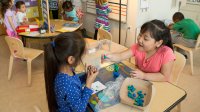Incorporating Montessori Practices in Station Rotation
Preschool and kindergarten teachers in non-Montessori schools can take advantage of Montessori strategies and learning materials.
Your content has been saved!
Go to My Saved Content.Children learn in many ways, including listening, reading, seeing, and doing, and it’s important for them to be in an environment that makes them feel happy, secure, and confident to build their sense of mastery in their activities.
Sir Ken Robinson’s TED Talk, “Bring on the Learning Revolution,” inspired me to create a student-centered learning environment. My primary goal is to develop pre-K and kindergarten students’ motor skills and provide a strong foundation for the development of social, emotional, cognitive, and physical skills, in order to encourage lifelong learning.
I’ll share the Montessori strategies I’ve used and the benefits I have experienced with my students, as well as when and how they can be used in a non-Montessori classroom.
How the Montessori Method Addresses Student Needs
Dr. Maria Montessori believed that children learn better when they feel comfortable with what they are learning. She created unique learning materials for children that are still used in many Montessori classrooms and help students develop calm, cooperative behaviors. Montessori believed that when students experience and develop independence, they learn how society is organized and develop the skills needed to meet future challenges in a positive way.
As a Montessori-certified teacher, I use practices that assess the needs of each student individually, focusing on experiential learning, critical thinking, and problem-solving. This attention to student needs, in addition to an emphasis on sensorial and creative activities, helps reduce behavioral issues and gives students the freedom to choose their own activities and master them at their own pace.
The beginning of a school year isn’t easy. Being consistent with constraints (boundaries with rules and guidelines) is key to a successful Montessori environment. It takes me a week to assess my students and identify areas of improvement. As an early childhood educator, when I notice my students performing tasks incorrectly, I ask myself two questions: “Is there an appropriate way to correct it? What happens if I don’t?”
Simple errors, when identified and addressed at an early stage, create an opportunity for students to overcome future hurdles in their learning path. But how should we correct them? Teachers often remind kindergarten and first-grade students to hold their pencils or crayons properly, but actions speak louder than words, and instead of just telling students what to do, I feel it’s important to introduce Montessori sensorial materials to students at the pre-K and kindergarten level that encourage the motor skills they’ll need as they continue on in school.
Montessori materials aren’t cost-friendly, and many public schools don’t have a budget for implementing the Montessori method of education. However, teachers can combine blended learning models that Michael Horn and Heather Staker suggest, such as station rotation, with Montessori-based activities.
Using Montessori Materials in Station Rotation
The station rotation model helps students grow efficiently and establishes a classroom routine. The idea of rotating among stations is certainly not new—it’s an established and effective practice in elementary schools. The new element that I propose is that Montessori materials be used in the cycle. As Horn and Staker write in their book, the key to this model is that the clock or the teacher announces that it’s time to rotate and everyone shifts to their next assigned activity in the class.
I’ve aligned Montessori materials and activities with the station rotation model in the following way for my students. You can adjust the activities every month to align with your classroom’s theme.
1. Teacher’s Station: Kids (groups of five work well) has one-on-one and group interactions with their teacher. The activity can be the teacher’s choice.
2. Technology Station: Each group of students works on a school-approved application, completing an activity related to the week’s theme—20 minutes of activity is plenty of time for students in the early grades.
- Schoology allows access to course materials anytime, anywhere, for teachers, students, and parents.
- Nearpod allows students to improve hands-on, mind-on engagement and simplifies classroom management.
- Epic directs students in self-learning and reading. This encourages students to discover and explore their personal interests.
- Google Slides helps teachers build a presentation and share it with other teachers regardless of location.
3. Independent Activity Station: Students use Montessori materials that can vary according to weekly themes.
- Lacing activities
- Sorting objects (colors, animals, shapes, numbers, etc.)
- Sensorial bin (colored rice, beans, colored pasta, plastic coins)
- Pin pricking/perforating the letters of the alphabet
- Pouring activities (sand or water)
- Spoon or measuring cup activities
4. Group Activity Station: At this station, students pair up to complete a task such as completing a large floor puzzle, a construction activity with building blocks, playing with a doll house, or restaurant role play using a kitchen play set.
For young children, connecting play and imagination with structure and constraints creates a beneficial and student-centered learning environment. Critical thinking skills are nurtured, and students develop a sense of ownership over their learning. As teachers committed supporting and being lifelong learners, every class presents an opportunity for us to model positive behaviors and to learn new things from our students.
